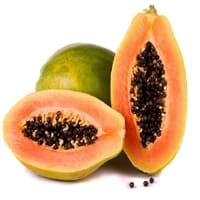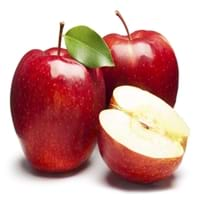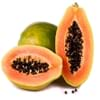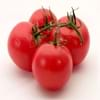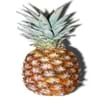Health Benefits
Arthritis prevention, Asthma treatment, Cancer prevention, Heart care, Prevents macular degeneration, Prevents rheumatoid
Cancer prevention, Supports healthy Liver function, Diarrhea treatment, Heart care, Increases metabolic rate, Neutralizes irritable bowel syndrome, Helps Prevent cataract, Prevents constipation, Prevents gall stones, Prevents high blood pressure, Helps prevent Parkinson's disease, Reduces risk of asthma, Treatment of alzheimer's disease
General Benefits
Anti-inflammatory properties, Boosts immune system, Digestive aid, Healing of wounds, Maintains healthy cholesterol level, Strengthens bones
Boosts immune system, Helps in weight loss, Maintains healthy cholesterol level, Whitens teeth
Skin Benefits
Anti-aging benefits, Hydrates skin, Skin revitalization, Treatment of acne, Treatment of dark spots
Anti-aging benefits, Brightens and lightens complexion, Hydrates skin, Treatment of acne, Treatment of dark spots, Treatment of puffy eyes
Hair Benefits
Good conditioner, Promotes longer and healthier hair, Softening mask, Treatment of dandruff
Prevents hair loss, Promotes longer and healthier hair, Regulates hair growth, Treatment of dandruff
Allergy Symptoms
Abdominal pains, Carotenemia on excessive consumtion, Latex Allergy
Abdominal pains, Itching, Swelling of mouth, tongue or lips, Vomiting
Side Effects
Allergic reaction, Skin problems, Possibly unsafe during pregnancy
Allergic reaction, May consist of poisonous seeds
Best Time to Eat
As a snack in the late afternoon, Don't consume at night and before bed, Don't eat after meal
Any time except an hour after meal, Best if taken as a breakfast (or empty stomach), Don't consume at night and before bed
Vitamin B5 (Pantothenic Acid)
Vitamin C (Ascorbic Acid)
Vitamin K (Phyllochinone)
Phytosterol
Not Available
Calories in Fresh Fruit with Peel
Not Available
Calories in Fresh Fruit without Peel
Type
Melon, Tree fruit
Tree fruit
Season
All seasons
All seasons
Varieties
Coorg Honey Dew, Pusa Dwarf, Pusa Giant, Pusa Majesty, Pusa Delicious, Pusa Dwarf, Solo, Ranchi, Taiwan-785 and Taiwan-786
Red Delicious, Golden Delicious, Gala, Fuji, Granny Smith, Arkansas Black, Sampion, Pink Lady, Cameo, Jonagold, Mc Intosh, Ananasrenette, Lobo, Pacific Rose, Yellow transparent and Bramley
Color
Orange, Yellow
Green, Red, Yellow
Inside Color
Orange
White
Taste
Luscious, Sweet
Sweet, Sweet-Sour
Origin
Mexico, Central America
Central Asia, Middle East Asia
Soil Type
Rocky, Sandy, Well-drained
Loam
Climatic Conditions
Warm, Without frosts
Cold
Facts about
- Papaya seeds show contraceptive effects in male monkeys.
- Their seeds are used as a replacement for black pepper in some nations due to peppery taste.
- Papaya is known by funny names like paw paw or papaw and the mamao.
- Apples can be as small as a pea and as big as a pumpkin.
- There are more than 8000 varieties of apples.
- Life of an Apple tree can be more than 100 years.
- Apples contain 25% air, therefore they float in water.
Other Countries
Brazil, Indonesia, Mexico, Nigeria
Chile, France, India, Iran, Italy, Poland, Russia, Turkey, United States of America
Top Importer
United States of America
Russia
Top Exporter
Mexico
China
Botanical Name
Carica papaya
Malus Domestica
Synonym
Not Available
Malus Communis or Malus Pumila or Pyrus Malus
Subkingdom
Tracheobionta
Tracheobionta
Division
Magnoliophyta
Magnoliophyta
Class
Magnoliopsida
Magnoliopsida
Subclass
Dillenhidae
Rosidae
Order
Brassicales
Rosales
Family
Caricaceae
Rosaceae
Species
C. papaya
M. domestica
Generic Group
Papaya
Rose
Difference Between Papaya and Apple
We might think that Papaya and Apple are similar with respect to nutritional value and health benefits. But the nutrient content of both fruits is different. Papaya and Apple Facts such as their taste, shape, color, and size are also distinct. The difference between Papaya and Apple is explained here.
The amount of calories in 100 gm of fresh Papaya and Apple with peel is Not Available and 52.00 kcal and the amount of calories without peel is 43.00 kcal and 48.00 kcal respectively. Thus, Papaya and Apple belong to Low Calorie Fruits and Low Calorie Fruits category.These fruits might or might not differ with respect to their scientific classification. The order of Papaya and Apple is Brassicales and Rosales respectively. Papaya belongs to Caricaceae family and Apple belongs to Rosaceae family. Papaya belongs to Carica genus of C. papaya species and Apple belongs to Malus genus of M. domestica species. Beings plants, both fruits belong to Plantae Kingdom.
